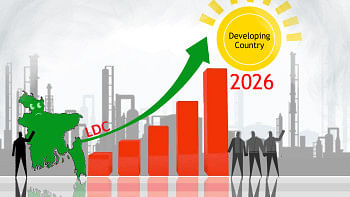FY25 budget reaction: The direction of the budget is correct

If we start from the beginning, the inflation rate was triggered by a sharp decline in the exchange rate depreciation in 2022. This happened because the current account experienced a deficit of more than $30 billion. Moreover, had we supported taka and mitigated the growing import pressure through a decisive hike in interest rate, then the depreciation would not have been as strong. This was then complemented by energy price adjustments. Exchange rate depreciation and energy price adjustments were the first two triggers for the inflationary spike we experienced.
The central bank should have responded to this growing inflationary pressure by embracing a contractionary monetary policy. Unfortunately, in 2022 and 2023, the central bank did not do so. It did not increase policy rate sharply, it did not tighten the money supply, in fact, it undertook central bank financing of the budget by printing high powered money and lending it to the government. These factors undermined the scope of the central bank to contain inflation. Of late, we have seen that the central bank has taken some corrective measures. It has abandoned the six-nine interest rate band, it has increased the policy rate to 8.5 percent, but that may still not be good enough to contain inflation.
Till date, inflation is around 10 percent, which is still much lower compared to countries like Pakistan and Turkey. However, we must remain very cautious about not letting inflation run wild. Interest rates must be kept high, the central bank cannot undertake financing of the budget, and easy money under a 8.5 percent policy rate cannot be given to commercial banks. High powered money creation cannot become a routine phenomenon.
The policymakers have identified the three key problems facing the economy. The first problem is inflation, the second problem is we have lost around $20 billion of foreign reserves over the last 24 months, and therefore we have to take measures to stabilise our balance of payments. The third is that we don't want to increase the debt burden through any expansionary fiscal policy. In the last budget, our Annual Development Programme (ADP) was around Tk 2 lakh crore, and it was totally financed through international and domestic borrowing. Our entire revenue is exhausted by the wage bill, the subsidy bill, and interest payments. This basically means that every penny we spend in our development budget is a penny that we have borrowed. To address these three issues, this budget needed a correct strategic shift—and had to prioritise contraction demand management.
On the whole, we needed this budget to prioritise economic stabilisation over economic growth. In other words, attention had to be paid to inflation, balance of payment, domestic resource mobilisation, cutting down expenditure, increasing the role of government revenue in financing development and reducing borrowing from the private sector to finance the budget. The government had to focus on economic stabilisation over economic growth by targeting inflation, foreign reserve management, and managing the growing debt burden to stabilise the economy over the next 12 to 16 months.
From initial impressions of the national budget for fiscal year 2024-25, it is promising that the budget deficit has been kept at 4.6 percent. It is the lowest budget deficit in 10 years, so that is indicative of a contractionary fiscal policy that supports the contractionary monetary policy of the central bank. The broad strategic direction is correct.
One point of concern is that the proposed budget outlines borrowing Tk 1,37,500 crore from the domestic banking sector. With projected deposit growth in the banking sector of Tk 1,60,000 crore, a structural obligation of borrowing such a large sum may drive Bangladesh Bank to step into budget financing, which will not be desirable.
Moreover, proposed social security spending is 17 percent of the budget, which could have been higher. When interest rates are raised, when public expenditure is reduced, then under a high inflationary climate, poor people or people living on a fixed income must be supported.
The fundamental challenge facing policymakers in implementing a contractionary budget will be patience. The central bank has been of late somewhat aggressive in trying to bring down inflation, but inflation is stubborn. Even after a lot of measures, inflation could still not be brought down to the seven percent threshold. The political challenge of trying to stabilise the economy is that the benefits come in the medium run, but the costs are incurred in the short run. In the short run, people feel the tighter budget, people feel the pain of a higher interest rate regime, but when the economy ultimately stabilises over a year, growth will bounce back, and people will also experience and see the broader benefits of the stabilisation policies undertaken.
As told to Azmin Azran of The Daily Star
Dr Ashikur Rahman is principal economist at the Policy Research Institute.
Views expressed in this article are the author's own.
Follow The Daily Star Opinion on Facebook for the latest opinions, commentaries and analyses by experts and professionals. To contribute your article or letter to The Daily Star Opinion, see our guidelines for submission.

 For all latest news, follow The Daily Star's Google News channel.
For all latest news, follow The Daily Star's Google News channel. 










Comments